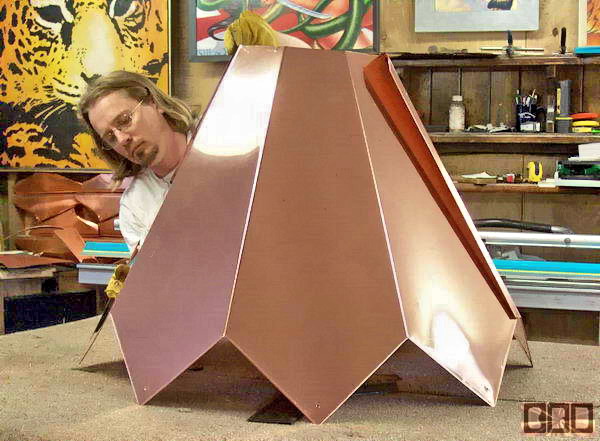|
Cheapest Metals Commonly Used:
|
|
Painted or Galvanized Steel:
is a cheap and strong metal, but it will rust out far too soon to be
practical (as seen in these photos).
Even a cheap roof cap that cost only $20 is too expensive considering
the trouble and cost to replace it every 10 years to avoid the permanent
rust stains that will occur if it is not replaced in time. Although a well built
copper cap should last well 100 years or so, being reused each time the
roofing is replaced.
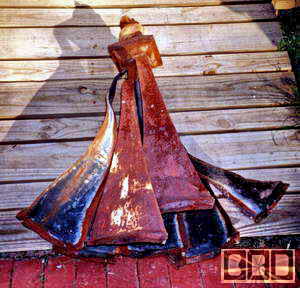 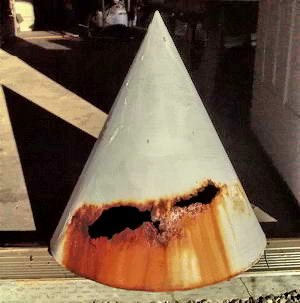
Sadly painted steel is by far the most common
metal used for roof flashing still today (well over 20 to 1 ratio), only because
it is a little cheaper than aluminum. Most professional roofing supply
distributors here in the NW do not even stock aluminum flashing, since
the roofing contractors won't buy it, so even the new roofers
think that's what is suppose to be used, since that's all they have
readily available. The savings to you as a Homeowner
is marginal, since most of the cost of any construction work is labor.
Even though copper cost 500% more than aluminum, steel roof cap
would only saves you
around 25% off the cost from using the thick 20oz copper I use,
so we do not even offer steel as an option.
|
|
Galvalum:
This may be better than galvanized or painted steel, but again it is
not worth the marginal savings from using copper, so I do not
offer this option either.
|
|
Aluminum:
is 1.5th the cost of copper, but only 20% more than steel. It
can be used for roof caps, but that sheet
metal is painted to make it less brash looking than just raw
aluminum. anything is only as good as it's weakest link and the
paint will get
chalky from the oxidization and will start to peal off and look bad
well before the roofing shingles had failed. It has a good baked on enamel
finish, but it still only has a 20 year life span at best, but at
least it
will still protect the roof for decades after that. To have it repainted would cost
more than to have a new cap made.
This painted surface will also mildew. So because of
these issues I have not had any clients even ask about this option,
since the savings would be marginal for custom work like mine.
|
|
Paint Free, Rust Free Metals: |
|
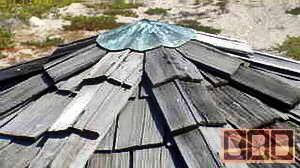 Lead:
If your looking to make a roof cap yourself this may be your best
option. Lead
is a common rust free metal used for a small roof cap (as shown here),
because it is such a soft metal that can be easy cut with just
household sizzors and molded quickly without any tools. Roofers
like it because hey can form it with their bare hands right there on the roof peak
in just a couple minutes. It is also so heavy that it does not even need to be
nailed down or caulked to the roof. It will last just fine, but it does not
leave much in the way of decorative option. Lead:
If your looking to make a roof cap yourself this may be your best
option. Lead
is a common rust free metal used for a small roof cap (as shown here),
because it is such a soft metal that can be easy cut with just
household sizzors and molded quickly without any tools. Roofers
like it because hey can form it with their bare hands right there on the roof peak
in just a couple minutes. It is also so heavy that it does not even need to be
nailed down or caulked to the roof. It will last just fine, but it does not
leave much in the way of decorative option.
|
|
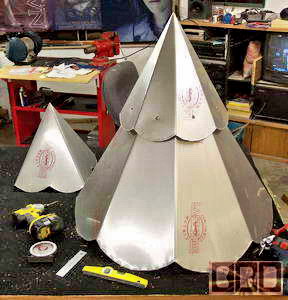 Stainless
Steel: is a good strong
metal that will last, but it remains that shinny mirror-like finish,
which stands out like a sore thumb until it's covered with mildew. Since it
is about the same cost as copper without the anti-fungal properties
of copper, it is rarely requested, but strongly pushed by other sheet-metal
shops for the reasons listed: Stainless
Steel: is a good strong
metal that will last, but it remains that shinny mirror-like finish,
which stands out like a sore thumb until it's covered with mildew. Since it
is about the same cost as copper without the anti-fungal properties
of copper, it is rarely requested, but strongly pushed by other sheet-metal
shops for the reasons listed:
Warning:
Other high-end shops will push stainless steel like it was the
best thing on Earth. Especially for chimney caps. That is
because stainless steel is quick to fabricate, since it can be simply
spot welded together. They also do not need to worry about finger
print oils making the metal surface tarnish unevenly. Another
reason you need to beware of this scam is how they will say they are
making it with stainless steel, but will actually use galvanized steel,
since they know you will not see it start to rust for a decade
or so. Well past the warranty period they may offer. Very
often some parts of it will not be stainless steel like the screen,
rivets, or bolts. You can simply test this with a magnet. The stainless steel
I use does not attract
a magnet at all.
|
|
Brass: is
just copper with
30% zinc mixed in to help reduce the cost and gives it that temporary
yellow look. It will still tarnish and turn black with age. The zinc
is a very soft metal, which makes brass a softer sheet metal than copper,
requiring a little thicker sheet to have the same dent resistance, so
it is pointless. |
|
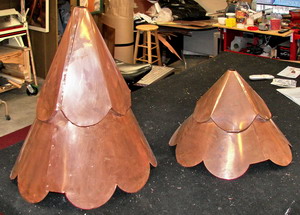 Copper:
is clearly the best long lasting value. A small sheet of thin copper
can be cut in a circle with scissors with a cut to the center to hand
bent into a simple overlapped cone shape, and nailed in place, but it
would not be reusable. That simple small cone shape is what you
may see most commonly when any metal is used since most roofers are
pretty simple people. Here is the best attempt we have seen a roofer
try to make. It was for our clients the Bogaards in Alabama
(you will notice we did not place our trademark
on this photo we had taken here in our shop).
They sent us these copper caps to use as a roof angle template. Below
is the new larger set we made for them with thicker copper and finial
support pipes built in. They were redesigned to be in proper proportion
to the individual turret roofs. Copper:
is clearly the best long lasting value. A small sheet of thin copper
can be cut in a circle with scissors with a cut to the center to hand
bent into a simple overlapped cone shape, and nailed in place, but it
would not be reusable. That simple small cone shape is what you
may see most commonly when any metal is used since most roofers are
pretty simple people. Here is the best attempt we have seen a roofer
try to make. It was for our clients the Bogaards in Alabama
(you will notice we did not place our trademark
on this photo we had taken here in our shop).
They sent us these copper caps to use as a roof angle template. Below
is the new larger set we made for them with thicker copper and finial
support pipes built in. They were redesigned to be in proper proportion
to the individual turret roofs.
We work to do a decent job with thicker copper
that will not deform or dent so easily, then accurately bent with the
same number of sides as the roof, then securely screwed in place with
stainless steel screws makes a better looking cover seal that will last
and can be easily reused. That is why we provide the stainless steel
screws with our fabrications. With any custom fabrication the labor
is what costs the most, so using a cheaper metal is foolish.
Copper is one of the few metal that are meant
to be seen. It will tarnish within a few months to a satin brown.
It actually takes nearly half a century to turn that chalky green, unless
special acids are applied to quicken this tarnish effect. This
dark earth-tone look makes copper a lot more appealing to most people.
Not so brash looking as with most other metals. It will stay clean,
since it will not mildew. It will also retard the growth of moss
on the roofing below it. The thicker 20oz copper we use is very good
for archival quality to last for well over a century if built well.
Copper also makes a great ridge cap for any roofing
in areas that suffer from moss growth and would keep the top edge of
the roof sealed better than the roofing shingles.
|
|
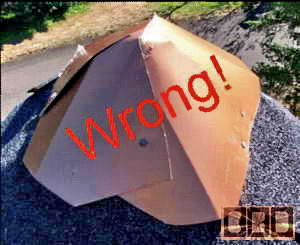 Warning:
Copper thickness is described differently that other metals.
It goes by weight per square foot. If they list it as 24 gauge; that
would mean it is only a thin copper plated steel at best. The 20oz copper
we use is about twice that thick. Other sheet-metal shops may claim
they use a thick copper, but they often still use just a thin copper
to save on cost. Or worse yet it is only copper looking painted steel
(as shown in this photo).
Solid copper will not attract a magnet, so this deception is easy to
test for. The problem is that you cannot test for this until after you
have taken delivery. At that point it is too difficult to resolve given
the added time delays and cost, so they count on the fact that few clients
will bother to check or complain if they had realized they were ripped
off. We are happy to mail you a free sample of the 20oz copper we use
upon request. We have lots of small scraps. Warning:
Copper thickness is described differently that other metals.
It goes by weight per square foot. If they list it as 24 gauge; that
would mean it is only a thin copper plated steel at best. The 20oz copper
we use is about twice that thick. Other sheet-metal shops may claim
they use a thick copper, but they often still use just a thin copper
to save on cost. Or worse yet it is only copper looking painted steel
(as shown in this photo).
Solid copper will not attract a magnet, so this deception is easy to
test for. The problem is that you cannot test for this until after you
have taken delivery. At that point it is too difficult to resolve given
the added time delays and cost, so they count on the fact that few clients
will bother to check or complain if they had realized they were ripped
off. We are happy to mail you a free sample of the 20oz copper we use
upon request. We have lots of small scraps.
|
|
Bronze:
is just 70% copper with other metals added to make it harder, so it
is too hard and brittle to bend. It is primarily used for casting. I
have not seen it in sheet metal form. |
|
Excellent Metals, but far too expensive: |
|
Titanium:
would be fantastic, but too hard to work with and it is still far too
expensive. |
|
Silver: would
be great, but way too expensive, so we have not even had any serious
inquiry for a sterling silver roof cap. But I'm sure it could
be done. |
|
Gold:
even a low grade 10k gold with lots of silver and copper mixed
in would be excellent, but only for those who have money to burn. We
have yet to meet such a client (LOL).
|









